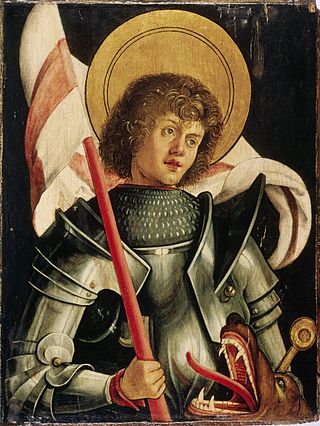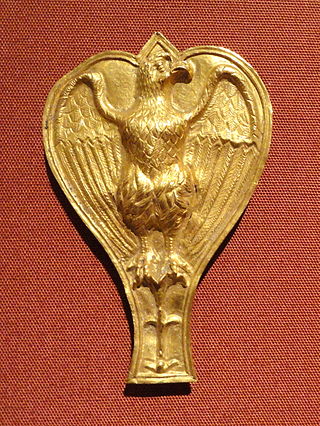
The draconarius was a type of signifer who bore a cavalry standard known as a draco in the Roman army.
Contents
 |
| Part of a series on the |
| Military of ancient Rome |
|---|

The draconarius was a type of signifer who bore a cavalry standard known as a draco in the Roman army.
 |
| Part of a series on the |
| Military of ancient Rome |
|---|
Strictly speaking, the word draconarius denotes the bearer of the military standard on which a dragon was represented. [1] The term passed into Christian usage, and was applied to the bearer of the labarum in battle, and also to cross-bearers in church processions. [2]
From the conquered Dacians, the Romans in Trajan's time borrowed the dragon ensign which became the standard of the cohort as the eagle was that of the legion. [3] Of Dacian, Sarmatian in origin, the draco was later generally introduced in the fourth century as a Roman standard. [4]
It consisted of a bronze dragon head with a fabric body similar in shape to a tail behind it. Wind flowed through the gaping mouth and billowed out the cloth tail much like a modern windsock. It is thought that some form of whistle was mounted in the dragon's neck to make a terrifying noise when galloping.

Saint George, also George of Lydda, was a Christian who is venerated as a saint in Christianity. According to tradition, he was a soldier in the Roman army. He was of Cappadocian Greek origin and a member of the Praetorian Guard for Roman emperor Diocletian, but was sentenced to death for refusing to recant his Christian faith. He became one of the most venerated saints and megalomartyrs in Christianity, and he has been especially venerated as a military saint since the Crusades. He is respected by Christians, Druze, as well as some Muslims as a martyr of monotheistic faith.

Dacia was the land inhabited by the Dacians, its core in Transylvania, stretching to the Danube in the south, the Black Sea in the east, and the Tisza in the west. The Carpathian Mountains were located in the middle of Dacia. It thus roughly corresponds to the present-day countries of Romania, as well as parts of Moldova, Bulgaria, Serbia, Hungary, Slovakia, and Ukraine.
Draco is the Greco-Latin word for serpent, or dragon.

Sir William Smith was an English lexicographer. He became known for his advances in the teaching of Greek and Latin in schools.

The Dacian draco was a military standard used by troops of the ancient Dacian people, which can be seen in the hands of the soldiers of Decebalus in several scenes depicted on Trajan's Column in Rome, Italy. This wind instrument has the form of a dragon with open wolf-like jaws containing several metal tongues. The hollow dragon's head was mounted on a pole with a fabric tube affixed at the rear. In use, the draco was held up into the wind, or above the head of a horseman, where it filled with air and gave the impression it was alive while making a shrill sound as the wind passed through its strips of material. The Dacian draco likely influenced the development of the similar Roman draco.

An aquila was a prominent symbol used in ancient Rome, especially as the standard of a Roman legion. A legionary known as an aquilifer, the "eagle-bearer", carried this standard. Each legion carried one eagle.

The Welsh Dragon is a heraldic symbol that represents Wales and appears on the national flag of Wales.

The ancient carnyx was a wind instrument of the Iron Age Celts, used between c. 200 BC and c. AD 200. It was a type of bronze trumpet with an elongated S shape, held so that the long straight central portion was vertical and the short mouthpiece end section and the much wider bell were horizontal in opposed directions. The bell was styled in the shape of an open-mouthed boar's, or other animal's, head.

The Costoboci were a Dacian tribe located, during the Roman imperial era, between the Carpathian Mountains and the river Dniester. During the Marcomannic Wars the Costoboci invaded the Roman empire in AD 170 or 171, pillaging its Balkan provinces as far as Central Greece, until they were driven out by the Romans. Shortly afterwards, the Costoboci's territory was invaded and occupied by Vandal Hasdingi and the Costoboci disappeared from surviving historical sources, except for a mention by the late Roman Ammianus Marcellinus, writing around AD 400.
According to the Historia Augusta, Firmus was a usurper during the reign of Aurelian. The contradictory accounts of his life and the man himself are considered to be a complete fabrication, perhaps based on the later Firmus.
In Roman mythology, Tranquillitas was the personification of tranquility. Tranquillitas seems to be related to Annona and Securitas, implying reference to the peaceful security of the Roman Empire. In the Roman context, the characteristics of Tranquilitas reflected the values at the heart of the Via Romana and are thought to be those qualities which gave the Roman Republic the moral strength to conquer and civilize the world.

The draco was a military standard of the Roman cavalry. Carried by the draconarius, the draco was the standard of the cohort, as the eagle was that of the legion.
The siege of Pirisabora took place when the Roman Emperor Julian besieged the fortified city of Pirisabora under Mamersides in April 363.
For most of its history, the Eastern Roman (Byzantine) Empire did not know or use heraldry in the Western European sense of permanent motifs transmitted through hereditary right. Various large aristocratic families employed certain symbols to identify themselves; the use of the cross, and of icons of Christ, the Theotokos and various saints is also attested on seals of officials, but these were often personal rather than family emblems. Likewise, various emblems were used in official occasions and for military purposes, such as banners or shields displaying various motifs such as the cross or the labarum. Despite the abundance of pre-heraldic symbols in Byzantine society from the 10th century, only through contact with the Crusaders in the 12th century, and particularly following the Fourth Crusade (1202–1204) and the establishment of Frankish principalities on Byzantine soil from 1204 onwards, did heraldic uses penetrate in Byzantium. A native Byzantine heraldry began to appear in the middle and lower rungs of aristocratic families in the 14th century, coinciding with the decline of imperial authority and with the fragmentation of political power under the late Palaiologan emperors. However, it never achieved the breadth of adoption, or the systematization, of its Western analogues.

Aquincum was an ancient city, situated on the northeastern borders of the province of Pannonia within the Roman Empire. The ruins of the city can be found today in Budapest, the capital city of Hungary. It is believed that Marcus Aurelius wrote at least part of his book Meditations at Aquincum.

A breviary is a liturgical book used in Christianity for praying the canonical hours, usually recited at seven fixed prayer times.
Acontisma or Akontisma, also called Hercontroma or Herkontroma, was a settlement in ancient Macedon near the border of Thrace on the coast and on the Via Egnatia, 8 or 9 miles eastward of Neapolis, on a pass of the same name. Its site has been identified with remains about 2 miles east of Nea Karvali.
Terentius was an Eastern Roman military commander whose recorded career flourished in the Caucasus region c. 369–374. He served the Roman Emperor Valens as comes rei militaris, most notably in the East.
Lucillianus was a high-ranking Roman army officer and father-in-law of the emperor Jovian. He fought with success in the war against Persia, and played a part in the execution of the emperor Constantius II's cousin, Gallus. In 361, Lucillianus was kidnapped by the emperor Julian and forced into retirement. He was recalled to service after the accession of his son-in-law Jovian in 363, and given a senior military command, only to be murdered that same year by mutinous troops in Gaul.